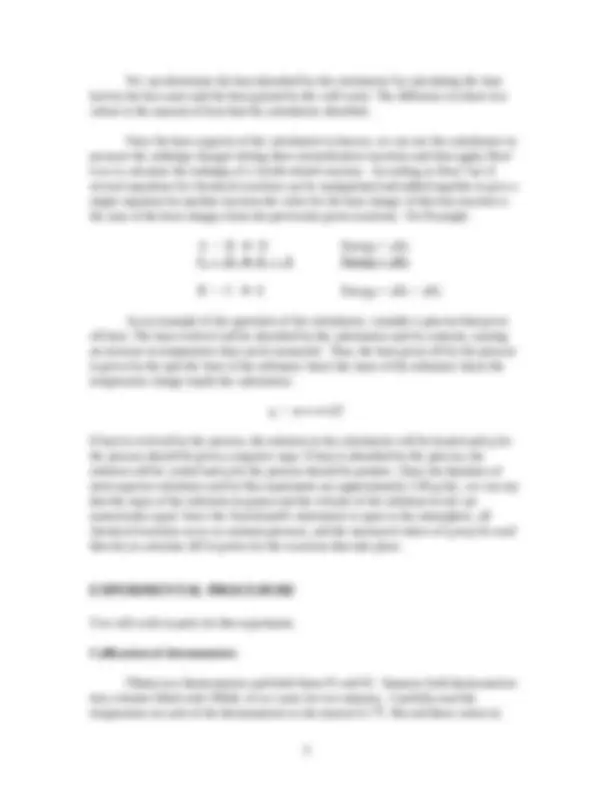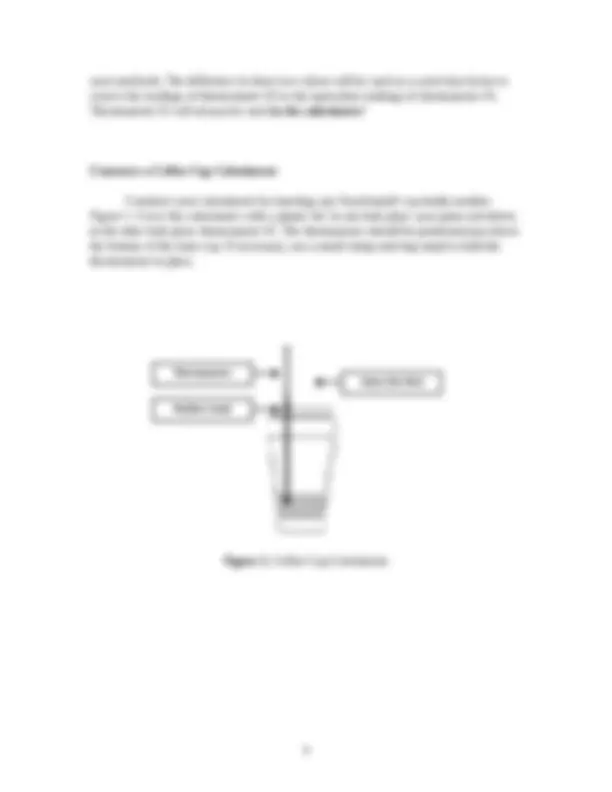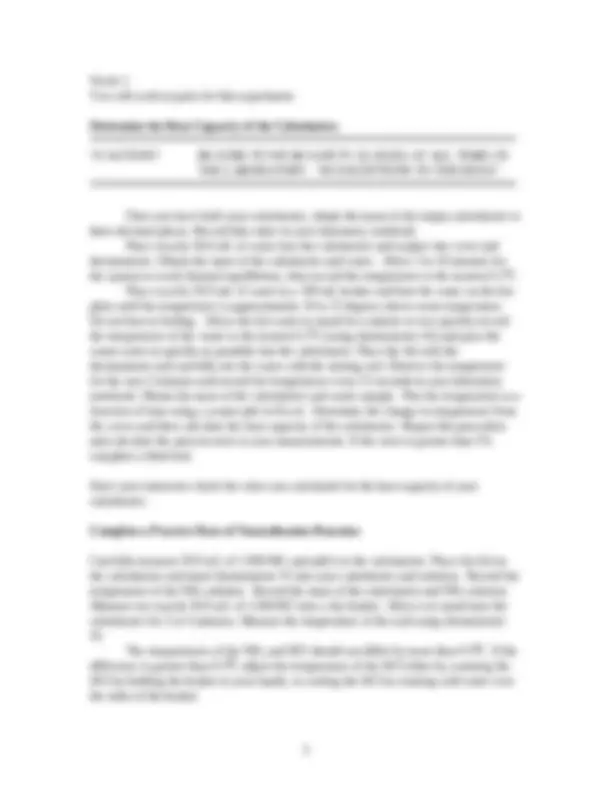





Study with the several resources on Docsity

Earn points by helping other students or get them with a premium plan


Prepare for your exams
Study with the several resources on Docsity

Earn points to download
Earn points by helping other students or get them with a premium plan
Community
Ask the community for help and clear up your study doubts
Discover the best universities in your country according to Docsity users
Free resources
Download our free guides on studying techniques, anxiety management strategies, and thesis advice from Docsity tutors
Material Type: Lab; Class: Principles of Chemistry Lab I; Subject: Chemistry; University: Clayton State University; Term: Unknown 1989;
Typology: Lab Reports
1 / 7

This page cannot be seen from the preview
Don't miss anything!




Heat is the most common form of energy involved in chemical changes, and in this experiment we will study heat energy in reactions. Most chemical processes are accompanied by an evolution or absorption of heat. The heat flow can be measured in a device called a calorimeter. A calorimeter is a container with insulating walls that minimizes the heat exchange with the surroundings. Within the calorimeter, chemical changes may occur and heat may pass from one part of the contents to another, but ideally no heat flows into, or out of, the calorimeter. The general symbol for heat flow in a process is “q”, and its values are usually given in units of joules (SI unit) or calories. If the process is carried out at constant pressure, q is given a special name – enthalpy change, ∆H. Thus, the heat absorbed or evolved during a process carried out at constant pressure is called the enthalpy change for that process. We will be working with processes carried out in a calorimeter that is partially open to the atmosphere; therefore, q = ∆H. In discussing enthalpy changes, most processes are written in the form of chemical equations. When studying the enthalpy changes in a reaction, the physical state of each substance is important. Be sure to include the state of each species in your balanced chemical reactions. The stoichiometric coefficients in the chemical equations are understood to represent the number of moles of each substance. Processes that proceed with the absorption of heat have positive values of ∆H and are said to be endothermic. Processes that evolve heat have negative values of ∆H and are said to be exothermic. Considerations of temperature and pressure are important, and unless otherwise noted, the chemical processes are studied at, or near, 25 °C and one atmosphere pressure. Thus, equation (1) below means that at 25 °C and one atmosphere of pressure, one mole of hydrogen gas and 1/2 mole of oxygen gas react to form one mole of liquid water with the evolution of 286 kJ of heat energy. H 2 (g) + ½ O 2 (g) H 2 O ( l ) ∆H = - 286 kJ (1) Temperature Changes When a “hot” object is placed in contact with a “cold” object (one having a lower temperature) heat energy will flow from the warmer body to the cooler one until both objects have the same temperature. It is obvious that the amount of heat energy required to cause a specific temperature change in a specific object must depend on the mass of the object. It takes more thought to realize that the amount of heat also depends on the chemical identity of the object. Thus, we define the specific heat, s , of a substance as the
amount of heat energy (joules) required to raise the temperature of one gram of the substance by exactly one degree Celsius. Specific Heat (joules/°C.^ g) = s = m ΔTT q
or q = m s ∆T q = heat energy gained or lost by the substance in Joules ∆T = (Tfinal – Tinitial ) in Degrees Centigrade or Kelvin m = mass of substance in grams The specific heat of a substance is a characteristic physical property of the substance. The specific heat of water is 4.184 J /°C g. The temperature change experienced by an object when it absorbs a certain amount of heat is determined by its heat capacity, C. The heat capacity of an object is defined as the amount of heat absorbed by a material to raise its temperature one °C. Heat Capacity = C = C Joules
In this experiment, we will use a “coffee cup calorimeter” to measure the heat given off during a set of acid base neutralization reactions. A coffee cup calorimeter consists of a nested pair of Styrofoam® cups, a stirrer, and a thermometer for measuring temperature changes. All processes are studied in dilute aqueous solution. The Styrofoam® cups are excellent insulators; the arrangement makes a surprisingly good calorimeter and effectively prevents heat loss to the surroundings over short periods of time. Because we are concerned with the heat of reactions and because some heat is absorbed by the calorimeter itself, we must know the amount of heat absorbed by the calorimeter. This requires that we determine the heat capacity of the calorimeter. The heat capacity of the calorimeter is measured by determining the temperature change that occurs when a known amount of hot water is added to a known amount of cold water in the calorimeter. The heat lost by the hot water should be completely absorbed by the cold water. This however does not happen but the heat lost by the hot water is equal to the heat gained by the cold water and the heat gained by the calorimeter. qhot = -qcold perfect system qhot = -qcold + heat absorbed by calorimeter actual system
your notebook. The difference in these two values will be used as a correction factor to correct the readings of thermometer #2 to the equivalent readings of thermometer #1. Thermometer #1 will always be used in the calorimeter! Construct a Coffee Cup Calorimeter Construct your calorimeter by inserting one Styrofoam® cup inside another, Figure 1. Cover the calorimeter with a plastic lid. In one hole place your glass rod stirrer; in the other hole place thermometer #1. The thermometer should be positioned just above the bottom of the inner cup. If necessary, use a small clamp and ring stand to hold the thermometer in place. Figure 1. Coffee Cup Calorimeter Thermometer Glass Stir Rod Rubber band
Week 1: You will work in pairs for this experiment. Determine the Heat Capacity of the Calorimeter.
!!CAUTION!! BE SURE TO WEAR SAFETY GLASSES AT ALL TIMES IN THE LABORATORY. NO EXCEPTIONS TO THIS RULE!
Once you have built your calorimeter, obtain the mass of the empty calorimeter to three decimal places. Record this value in your laboratory notebook. Place exactly 50.0 mL of water into the calorimeter and replace the cover and thermometer. Obtain the mass of the calorimeter and water. Allow 5 to 10 minutes for the system to reach thermal equilibrium; then record the temperature to the nearest 0.1C. Place exactly 50.0 mL of water in a 100 mL beaker and heat the water on the hot plate until the temperature is approximately 10 to 15 degrees above room temperature. Do not heat to boiling. Allow the hot water to stand for a minute or two quickly record the temperature of the water to the nearest 0.1C (using thermometer #2) and pour the warm water as quickly as possible into the calorimeter. Place the lid with the thermometer and carefully stir the water with the stirring rod. Observe the temperature for the next 3 minutes and record the temperature every 15 seconds in your laboratory notebook. Obtain the mass of the calorimeter and water sample. Plot the temperature as a function of time using a scatter plot in Excel. Determine the change in temperature from the curve and then calculate the heat capacity of the calorimeter. Repeat this procedure and calculate the percent error in your measurements. If the error is greater than 5% complete a third trial. Have your instructor check the value you calculated for the heat capacity of your calorimeter. Complete a Practice Heat of Neutralization Reaction : Carefully measure 50.0 mL of 1.0M NH 3 and add it to the calorimeter. Place the lid on the calorimeter and insert thermometer #1 into your calorimeter and solution. Record the temperature of the NH 3 solution. Record the mass of the calorimeter and NH 3 solution. Measure out exactly 50.0 mL of 1.0M HCl into a dry beaker. Allow it to stand near the calorimeter for 3 or 4 minutes. Measure the temperature of the acid using thermometer #2. The temperatures of the NH 3 and HCl should not differ by more than 0.5C. If the difference is greater than 0.5C adjust the temperature of the HCl either by warming the HCl by holding the beaker in your hands, or cooling the HCl by running cold water over the sides of the beaker.
Heat of Neutralization of HCl-NaOH Take out the calorimeter and obtain the mass of the empty calorimeter. Carefully measure 50.0 mL of 1.0M NaOH and add it to the calorimeter. Place the lid on the calorimeter and insert thermometer #1 into your calorimeter and solution. Record the temperature of the NaOH solution. Record the mass of the calorimeter and NaOH solution. Measure out exactly 50.0 mL of 1.0M HCl into a dry beaker. Allow it to stand near the calorimeter for 3 or 4 minutes. Measure the temperature of the acid using thermometer #2. The temperatures of the NaOH and HCl should not differ by more than 0.5C. If the difference is greater than 0.5C adjust the temperature of the HCl either by warming the HCl by holding the beaker in your hands, or cooling the HCl by running cold water over the sides of the beaker. Once both solutions are the same temperature, lift the lid and carefully add the 1. M HCl all at once. Be careful not to splash any on the upper sides of the cup. Stir the solution gently with the stirrer and record the temperature as a function of time every 15 seconds for the next 3 minutes in your laboratory notebook. Obtain the mass of the calorimeter with the acid and base. Construct a temperature verses time curve using Excel and determine the change in temperature. Calculate the heat of neutralization per mole of water formed. You may assume that the NaCl solution has the same density and specific heat as water. Heat of Neutralization of Acetic Acid and NaOH Follow the same procedure as above but substitute the 1.0 M acetic acid for the 1.0 M HCl. Calculate the heat of neutralization per mole of water formed. Heat of Neutralization of Acetic Acid and Ammonia Follow the same procedure as above but substitute 1.0 M ammonia for the NaOH solution. Calculate the heat of neutralization per mole of water formed.
!!REMINDER!! BE SURE TO RETURN THE THERMOMETERS BEFORE YOU LEAVE THE LAB!
Hess’ Law Use your values for the enthalpy of reaction for each of the three reactions above to calculate the enthalpy of reaction for the reaction of hydrochloric acid with ammonia. HCl (aq) + NH 3 (aq) NH 4 Cl (aq)